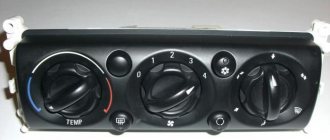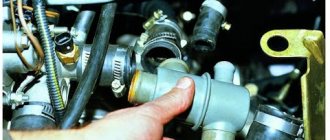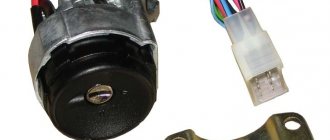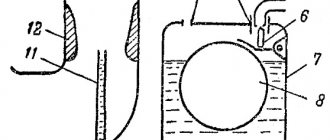Problems with starting arise not only for cars that have seen the world: owners of cars that have covered only a few thousand kilometers can also encounter difficulties with “hot” or “cold” starting of the engine. What is the cause of technical malfunctions in the first and second cases?
Outside the window - 22 °C. Should I warm up the engine before starting?..
Engine is bad: 5 possible reasons
- Poor quality gasoline or diesel fuel. The fuel may contain additives that are not suitable for a particular brand of car, or solid particles that cause filter clogging. In cold weather, diesel fuel can turn into a jelly-like form, which is difficult to pump.
- If the coolant temperature sensor malfunctions, the correct supply of fuel is disrupted.
- The mass air flow sensor has failed.
- The tightness of the fuel injectors is broken, for example, the sealing rings are damaged, which leads to gasoline leakage and an over-rich mixture.
- Failure of the fuel injection pump, for example due to wear of the bushings and drive shaft oil seal, is the main reason for difficult “hot” starting in diesel cars.
Sometimes the source of the problem lies in a clogged air filter or oxidation of the battery contacts. Replacing consumables or components does not always solve the problem - you should start with a comprehensive diagnosis.
The cause of poor starting of domestic cars when hot is often overheating of the fuel pump
If the problem of difficult starting affects a car on which there is a gas installation, the tightness of the hoses may have been damaged due to damage to the sealing elements due to high temperature. The leakage of the working environment could have occurred for another reason. Gas is not something to joke about - you need to consult a specialist.
We start the engine in cold weather. What is the minus limit?
Expert opinion
When is a car required to work?
Denis Zagarin, Director of the NAMI Test Center
Denis Zagarin, Director of the NAMI Test Center
Technical Regulations of the Customs Union 018/2011 “On the safety of wheeled vehicles” compulsory requirements regarding the maximum temperatures at which the vehicle must remain operational are regulated only for emergency vehicles (from minus 40 °C to plus 40 °C).
For other categories of vehicles, temperature limits are set by the manufacturer and are given in the operating manual (usually from minus 40 °C to plus 40 °C).
Standard values of operating temperature ranges and maximum operating temperatures are also given in GOST 15150–69 (with current amendments). For vehicles with “basic” climatic version “U” these values range from minus 40 °C to plus 40 °C.
The whole truth about cold starts
Almost all drivers, if they don’t know for sure, then guess that starting the engine without preheating is harmful. That’s right: haste in this matter leads to rapid wear of rotating and rubbing components - pistons, cylinders, liners, crankshaft journals. The thickened oil does not immediately enter the mechanisms; the latter are left without lubrication and are forced to work “dry”. But it turns out it's not all bad news.
One cold start wears out the engine as much as driving 180-250 km
Conclusion
In general, the problem of cold starting is very relevant for the Russian Federation, because the majority of cars in our country are operated in a wide temperature range. To prevent the consequences of a cold start, it is necessary not only to fill in high-quality oil, but also to monitor the condition of the battery, starter, spark plugs and all elements of the car that affect the speed of starting the internal combustion engine. If all components of the car work properly and high-quality oil is poured, then the consequences of a cold start will not be critical.
In general, if your car has already traveled more than 150,000 km, it is recommended to change the oil between seasons. These small expenses will extend the life of your motor.
To ensure that your car does not let you down in winter, you should definitely prepare it for frost and use the interior heating system correctly.
Subscribe to YandexZen
2 363
Starting the engine “cold” can be difficult due to:
- a discharged battery that is unable to spin the starter and crankshaft flywheel (at sub-zero temperatures it discharges more strongly than usual);
- malfunctions of the fuel injection system;
- gaps between the cylinder and the piston, which appeared due to the narrowing of the sealing rings (if the tightness of the combustion chamber is broken);
- breakdowns of the starting nozzle, resulting in leaks;
- distributor cap defects, etc.
There is one more point - environmental. Fuel at low temperatures ignites less easily, so a “cold” engine requires a richer fuel mixture. This significantly increases the amount of harmful substances released into the atmosphere. By warming up your car for 10-15 minutes, you can make your own contribution to environmental protection.
There are actually many more reasons why the engine refuses to start. Sometimes replacing or cleaning the spark plugs, installing a new air, fuel or oil filter, or updating the O-rings helps. And sometimes you can get by with tidying up the throttle valve or other elements of the intake tract. Often it is not possible to independently determine the source of the problem, and is it worth it if a good service station can do it faster and better?
avtoexperts.ru
As in the popular joke, winter has come again unexpectedly: in Siberia, nights with -30° are no longer uncommon, and in the European part of the country, temperatures of -10° will no longer surprise anyone. Everyone knows that in winter it is harder for cars and their owners than in summer. This manifests itself in many aspects, but it starts with starting the engine. A frozen engine is more difficult to start, even children know this, but why exactly and how to deal with it? For novice car enthusiasts who own a car for their first or second winter, this information will be especially relevant.
Starting a cold engine
Battery
Without a working battery, you cannot start a car either in winter or in summer, this is a fact, but it is in the cold season that the problem becomes most pressing. The fact is that frost negatively affects the battery charge. Not only in the car, any “battery” suffers, but if we keep phones, tablets, cameras at home, or, in extreme cases, carry them along the street in a warm pocket, then the car battery is almost always left in the cold. It is not surprising that the cold reveals all his weaknesses. In the summer, “tired” batteries are still able to turn the starters, but in the winter they no longer have enough strength to do so.
There is no magic - just the laws of physics, the charge drops, and then higher recoil is required to turn the frozen mechanisms. So the battery needs extra attention in winter. To avoid getting into trouble, it is recommended to check the battery periodically.
This can be done either with a multimeter (it is recommended that the voltage on an unstarted car does not fall below 12.4 V) or with a hydrometer (the density of the electrolyte is measured, the recommended value is not lower than 1.27 g/cm3 at a temperature of -10 degrees). If the readings are lower, then you can recharge the battery and do regular checks. If you don't have enough charge for a long time, you will most likely have to buy a new battery.
Checking the battery with a multimeter
There is a little trick to mobilize all the battery power. Before starting, you need to turn on the high beams for 10-15 seconds . The charge will not drop much from this, but the electrolyte will warm up a little, this will help give the maximum. But during the launch itself, the high beams, like other electrical consumers (stove, heaters, tape recorder), must be turned off so as not to waste power.
There is also, of course, the time factor. Even in optimal conditions, the battery needs periodic recharging, let alone cold weather. Even a working battery may not survive standing outside for a week at -30°. If you plan not to drive for a long time, it is better to remove the battery and take it to a warm place. The effort spent on removal and installation will be required much less than dancing with a tambourine around a frozen car.
Engine oil
Motor oil in the engine is affected by temperature, the colder it is outside, the more it thickens. When starting up for the first time, mechanisms with thickened lubricant are more difficult to turn, hence the problem.
It would seem that you should use a thinner oil that thickens less and not worry about it. But too thin oil has its drawbacks, especially in the warm season. Previously, drivers simply changed the oil twice a year: in the winter they filled it with a thinner one, in the summer with a thicker one. Modern maintenance standards do not divide oils into seasons, although perhaps there is a reason for this in some operating modes.
Engine oil viscosity
In any case, when choosing an oil, you need to be guided by the tolerances and recommendations from the manufacturer, but if you live in an area with cold winters, then it is better to choose the thinnest oil allowed . And, of course, priority is given to synthetics, they are less susceptible to thickening. There are more chances to start the engine with it.
Candles
This factor is not often paid attention to during a cold start, but it’s a pity, it can also contribute. During operation, spark plugs wear out and the gap gradually increases. And it is known that the larger the gap, the weaker the spark. Here the situation is like with a battery - for driving on a warm engine the deviation is not critical, but on a cold start it can already affect it.
However, if you adhere to the regulations for replacing spark plugs, then there should be no problems. Modern maintenance programs are quite humane to spark plugs; most manufacturers recommend changing them every 30 thousand, while others recommend changing them at every maintenance. High-quality spark plugs should work for 15-30 thousand kilometers without problems, but if you delay the replacement too much, then anything is possible.
Spark plug
During a cold start, the spark plugs may still suffer from attempts to start the engine. If you turn the starter for too long, the spark plugs can be filled with gasoline , after which it is useless to continue trying without drying. By the way, if anyone doesn’t know, the drying mode can be turned on by pressing the gas pedal to the floor while the starter is running. In this case, gasoline stops flowing, but the intake and exhaust valves continue to operate, creating the necessary ventilation in the cylinder.
Compression
Another parameter that worsens a cold start is the compression of the metal and changes in the gaps between the motor components. The valve mechanism and cylinder-piston group at -30° already have different clearances. This leads to loss of compression upon first start, and good compression is necessary to start the engine . When the engine warms up a little, compression will be restored, but how can you warm it up without starting it? Preheaters are becoming increasingly popular (especially on diesel engines, where the problem is more pronounced), but they still remain a rather expensive exotic for mass users.
Pre-heater
There are also, of course, old-fashioned methods with a soldering iron under the engine crankcase (at the same time you can make the oil thinner) or a hairdryer on the intake manifold. As a last resort, they can also be used.
Warming up the engine before starting
It is worth mentioning that fresh engines with low mileage are unlikely to fail to start in cold weather only for this reason; they have a high compression margin, and a slight decrease in compression should not cause a problem. But “tired” engines with high mileage may encounter such a situation. The nuance is also that the owner of the car is not able to influence the situation; as they say, you cannot argue against the laws of physics. But he may not bring the engine of his car to the state of “firewood”. If you repair the engine in a timely manner, you won’t have to complain about compression problems later.
Instead of output
It must be admitted that the transition from carburetor engines to injectors has reduced the severity of the cold start problem. To start a car with a carburetor sometimes required a fine game with the gas pedal, a feel for the car and experience. Moreover, this was not even a malfunction, but a feature that had to be put up with. With the injector it’s easy - sat down, started it, or didn’t start it for some specific reason. Most modern cars in good condition start without problems at -30°, and even lower. However, such opportunities relax and discourage drivers - they cease to control the condition of the car . This is where the danger lurks of somehow going out in the morning and not starting the car.
How to properly start an engine using a quick start aerosol?
This procedure must be done carefully and correctly. Namely, we inject 2-3 seconds into the intake manifold, start the engine
If the car started before, but then it gets cold and doesn’t start, then there is a 90% chance that everything will work out. If it doesn’t work out, then repeat the procedure again, and you will thereby cover another 9% of the probability. If this does not help, then there is no need to try a third time. There is no need to inject for 5 seconds, or even 10, as some do. Then they are surprised that something is broken. Let us repeat once again - within the framework of standards adopted throughout the world for the use of this product, it will not harm your engine in any way. Another thing is that it’s difficult to hold on when it didn’t work out the first two times, but you need to go as soon as possible, then what if, what if.
Remember: if a safe portion does not help, then the problems are much more serious. And even though you inject the entire cylinder into the engine, this is unlikely to help you.
Understand that essentially all motors are the same.
— A strange property of my physiognomy: it seems to everyone that they just saw me somewhere.
“And you are stereotypical,” answered the general. - Similar to many others.
Y. Semenov, “Seventeen Moments of Spring”
Of course, the engine of a modern car is much more perfect than, say, that of pre-war carriages - just as a modern person is more perfect than a Cro-Magnon man. However, from a formal point of view, there is no fundamental difference between them. The human skeleton consists of the same bones as thousands of years ago, and pistons, rings and other connecting rods still work inside the internal combustion engine. No Martian materials are used in this case, and therefore, when temperature changes occur, the Aurus and Emoji motors will feel the same discomfort. Even if there is not a word about it in the press release.
It’s not good to “stink” under other people’s windows—no doubt about it. But the internal combustion engine cannot warm up instantly.
It’s not good to “stink” under other people’s windows—no doubt about it. But the internal combustion engine cannot warm up instantly.
Why is it difficult to start a cold engine?
reasons why there are problems starting the unit when it is cold . It is important to distinguish between situations: the car is hot, but at the same time it does not start well, the car does not start well when it cools down, after being idle, it refuses to start in cold weather. Each reason should be considered separately, but among them there are those that occur in 90% of cases. Before starting diagnostics, it is necessary to more accurately localize the fault. First of all, you should make sure that the battery is well charged, there is winter oil in the engine (summer oil gets very thick in the cold) and the starter turns the engine smoothly (at the same speed). If the cause is still related to the influence of low temperatures, the problem can be solved by installing an automatic engine heating system, but if problems with starting the unit occur even at positive temperatures, you should continue troubleshooting.











